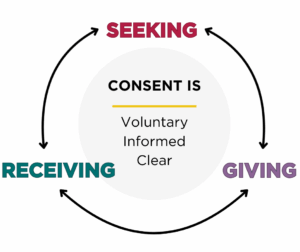Overview
This summary describes research on consent for sexual activity (referred to as consent). Consent is defined as a voluntary, informed, and mutual agreement among those involved in sexual activity, conveyed through clear words or actions by individuals who are fully able to make such a decision. Consent is the foundation for safe and respectful sexual activity. The concept of consent has three interconnected processes:
- Giving consent—communicating one’s willingness to engage in sexual behavior. Giving consent also includes communicating that one does not want to engage in sexual behavior.
- Seeking consent—inquiring about whether one agrees to sexual behavior or learning the partner(s) does not agree, through verbal or nonverbal signs.
- Receiving consent—the process through which an individual interprets whether they have received consent from another person and acts accordingly.

Throughout this summary, we refer to consent as agreement to engage in sexual activity. We also address the equally important decision to decline to engage in sexual activity.
Suggested citation: Rosenberg, R., Rivas-Koehl, M., Mihalec-Adkins, B., Schlecht, C., Parekh, J., & Rivas-Koehl, D. (2025). Seeking, Giving, & Receiving Consent for Sexual Activity. Child Trends.

